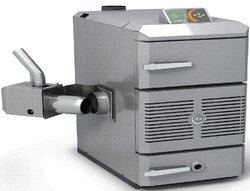My wife and I have a house under contract and are doing the necessary due diligence. All looks good until we start asking about the furnace/boiler system in place. At the end of this post, I have some thoughts on what we could do and would really like your thoughts. But first, here's what we know about the heat source so far:
- There is a 30+ year old combo oil/wood, forced hot air furnace in the basement that heats the 1st and 2nd floor.
- Next to the combo unit there is an older (15-20 year old) oil fed coil boiler that baseboard heats the 3rd floor and a 1st floor addition. The current tenants don't use this much because they don't have access to the 3rd floor per lease agreement and there is a pellet stove in the addition.
- A new, as of 2011, electric water heater is the primary DHW source.
My concerns with the existing system focus on whether it is up to code and if it will allow us to be insured. I have not been able to identify the make of the oil/wood combo and the stand-alone oil boiler is obviously inefficient and on it's last leg. The house has three floors plus basement and is about 3,000 sf. Aside from some older windows, it is relatively well insulated. More can be done in the basement and with the windows, but that's about it. Although we have not been able to verify this, it appears both the oil/wood furnace and oil boiler exhaust through the same flue, which is likely against code here in Maine. (Does anyone know if a combo oil/wood burner is allowed to exhaust through one flue?)
Although probably not the most efficient set up by today's standards, I think our lifestyle could coexist with this set up. However, if we need to make changes to meet code to get insured, this is what I'm thinking we could do.
- Remove existing oil/wood furnace combo, oil boiler and electric HW tank
- Install a wood stove in the basement directing as much heat up through the existing duct work to heat the 1st and 2nd floors, and 3rd floor by natural convection
- Install a high efficiency boiler (gas, oil, ????) to provide heat to the baseboards on the 1st & 3rd floors when needed as well to provide DHW. Could this be done with a pellet boiler?
What I don't like about this set up is that if we were to have an extended absence from home during the winter months, there is no automated way to keep the house warm unless we were to use some form of electric heat.
I know I've covered a lot in this post and I'm happy to answer any questions. If we can live with the existing system in the short-term we will. But, if we have to invest in a new system, what should it be? In no particular order, we want to be efficient, inexpensive and warm. Everyone's dream, right?
- There is a 30+ year old combo oil/wood, forced hot air furnace in the basement that heats the 1st and 2nd floor.
- Next to the combo unit there is an older (15-20 year old) oil fed coil boiler that baseboard heats the 3rd floor and a 1st floor addition. The current tenants don't use this much because they don't have access to the 3rd floor per lease agreement and there is a pellet stove in the addition.
- A new, as of 2011, electric water heater is the primary DHW source.
My concerns with the existing system focus on whether it is up to code and if it will allow us to be insured. I have not been able to identify the make of the oil/wood combo and the stand-alone oil boiler is obviously inefficient and on it's last leg. The house has three floors plus basement and is about 3,000 sf. Aside from some older windows, it is relatively well insulated. More can be done in the basement and with the windows, but that's about it. Although we have not been able to verify this, it appears both the oil/wood furnace and oil boiler exhaust through the same flue, which is likely against code here in Maine. (Does anyone know if a combo oil/wood burner is allowed to exhaust through one flue?)
Although probably not the most efficient set up by today's standards, I think our lifestyle could coexist with this set up. However, if we need to make changes to meet code to get insured, this is what I'm thinking we could do.
- Remove existing oil/wood furnace combo, oil boiler and electric HW tank
- Install a wood stove in the basement directing as much heat up through the existing duct work to heat the 1st and 2nd floors, and 3rd floor by natural convection
- Install a high efficiency boiler (gas, oil, ????) to provide heat to the baseboards on the 1st & 3rd floors when needed as well to provide DHW. Could this be done with a pellet boiler?
What I don't like about this set up is that if we were to have an extended absence from home during the winter months, there is no automated way to keep the house warm unless we were to use some form of electric heat.
I know I've covered a lot in this post and I'm happy to answer any questions. If we can live with the existing system in the short-term we will. But, if we have to invest in a new system, what should it be? In no particular order, we want to be efficient, inexpensive and warm. Everyone's dream, right?


